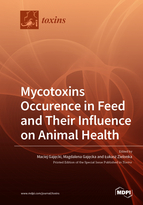Mycotoxins Occurence in Feed and Their Influence on Animal Health
A special issue of Toxins (ISSN 2072-6651). This special issue belongs to the section "Mycotoxins".
Deadline for manuscript submissions: closed (30 June 2020) | Viewed by 58642
Special Issue Editors
Interests: mycotoxins; detection; feed; mycotoxicosis; diagnostics; animal pathology; human pathology
Special Issues, Collections and Topics in MDPI journals
Interests: mycotoxins; detection; feed; low doses; mycotoxicosis; diagnostics; animal pathology; human pathology
Special Issues, Collections and Topics in MDPI journals
Interests: mycotoxins; detection; mycotoxicosis; diagnostics; animal pathology
Special Issue Information
Dear Colleagues,
Animal feeds, feedstuffs, and feed materials are frequently contaminated with undesirable substances, such as mycotoxins. According to various organizations evaluating the quality of plant materials, exposure to various mycotoxin doses in feed can have unpredictable consequences during mycotoxicosis. This uncertainty is associated with both the dose and the duration of exposure. Small and moderate doses often produce surprising effects, as follows: (i) the body fails to recognize the presence of undesirable substances, such as mycotoxins, and the underlying principle is similar to the T-regs theory; (ii) mycotoxin absorption increases during prolonged per os exposure; (iii) a compensatory effect is observed, which inhibits the activity of the analyzed factors, and homeostasis is restored despite ongoing exposure; and (iv) biomarkers of gastrointestinal functionality are detected. Mycotoxins alter the gut microbiome, and they can contribute to immune, endocrine, and metabolic disorders. These symptoms are difficult to identify and more difficult to interpret correctly.
For this reason, the Special Issue of Toxins will focus on the responses of selected bodily systems and functionality biomarkers in animals to various doses of mycotoxins causing mycotoxicosis. The resulting knowledge will deepen our understanding of mycotoxins’ impact on animal health, and it will facilitate decision making in risk management. Your scientific input into the Special Issue will be much appreciated.
Prof. Dr. Maciej Gajęcki
Prof. Dr. Magdalena Gajęcka
Dr. Łukasz Łukasz Zielonka
Guest Editors
Manuscript Submission Information
Manuscripts should be submitted online at www.mdpi.com by registering and logging in to this website. Once you are registered, click here to go to the submission form. Manuscripts can be submitted until the deadline. All submissions that pass pre-check are peer-reviewed. Accepted papers will be published continuously in the journal (as soon as accepted) and will be listed together on the special issue website. Research articles, review articles as well as short communications are invited. For planned papers, a title and short abstract (about 100 words) can be sent to the Editorial Office for announcement on this website.
Submitted manuscripts should not have been published previously, nor be under consideration for publication elsewhere (except conference proceedings papers). All manuscripts are thoroughly refereed through a double-blind peer-review process. A guide for authors and other relevant information for submission of manuscripts is available on the Instructions for Authors page. Toxins is an international peer-reviewed open access monthly journal published by MDPI.
Please visit the Instructions for Authors page before submitting a manuscript. The Article Processing Charge (APC) for publication in this open access journal is 2700 CHF (Swiss Francs). Submitted papers should be well formatted and use good English. Authors may use MDPI's English editing service prior to publication or during author revisions.
Keywords
- Feed
- Mycotoxins
- Mycotoxicosis
- Animal pathology
- Detection Diagnostics
- Gastrointestinal tract
- Intestinal microbiome
- Intestinal mycobiome
- Intestinal genotoxicity








